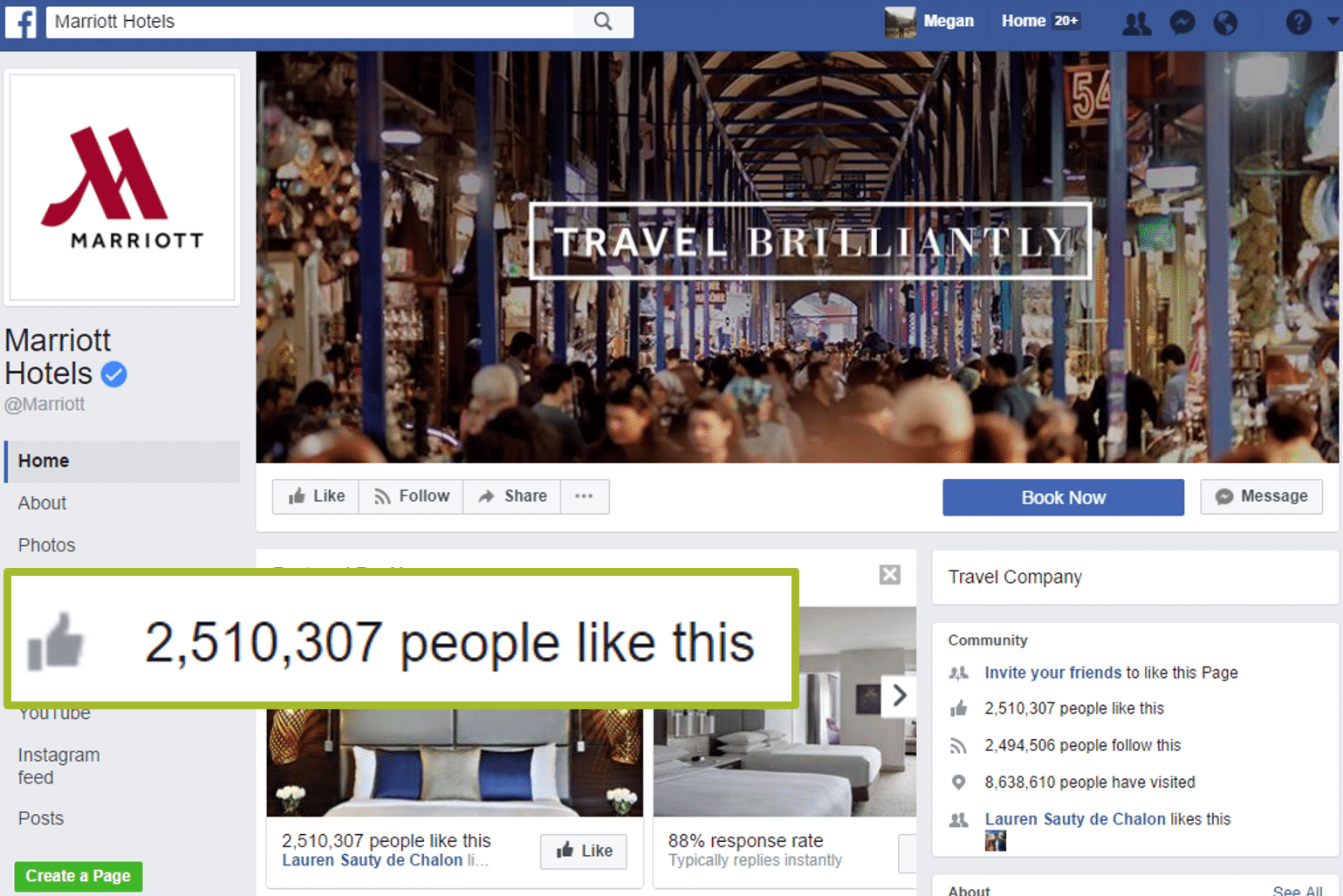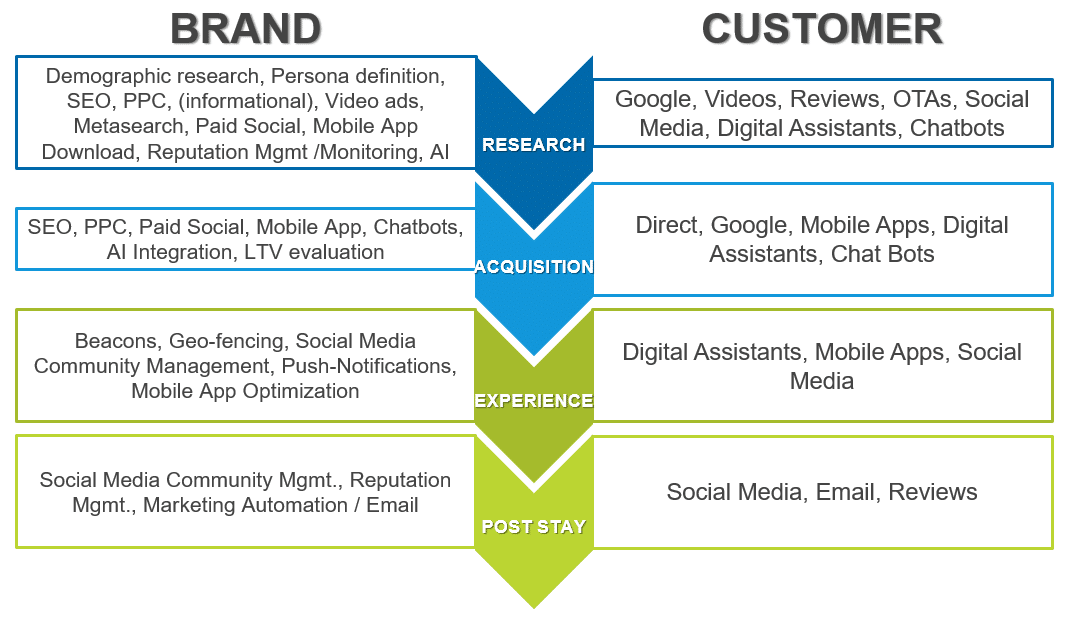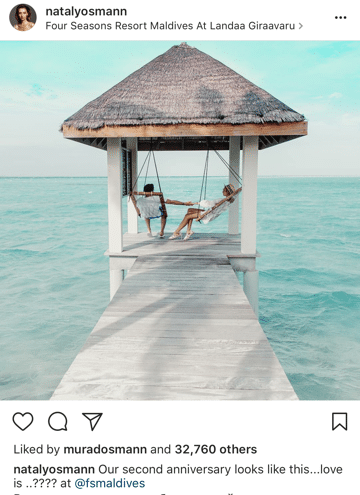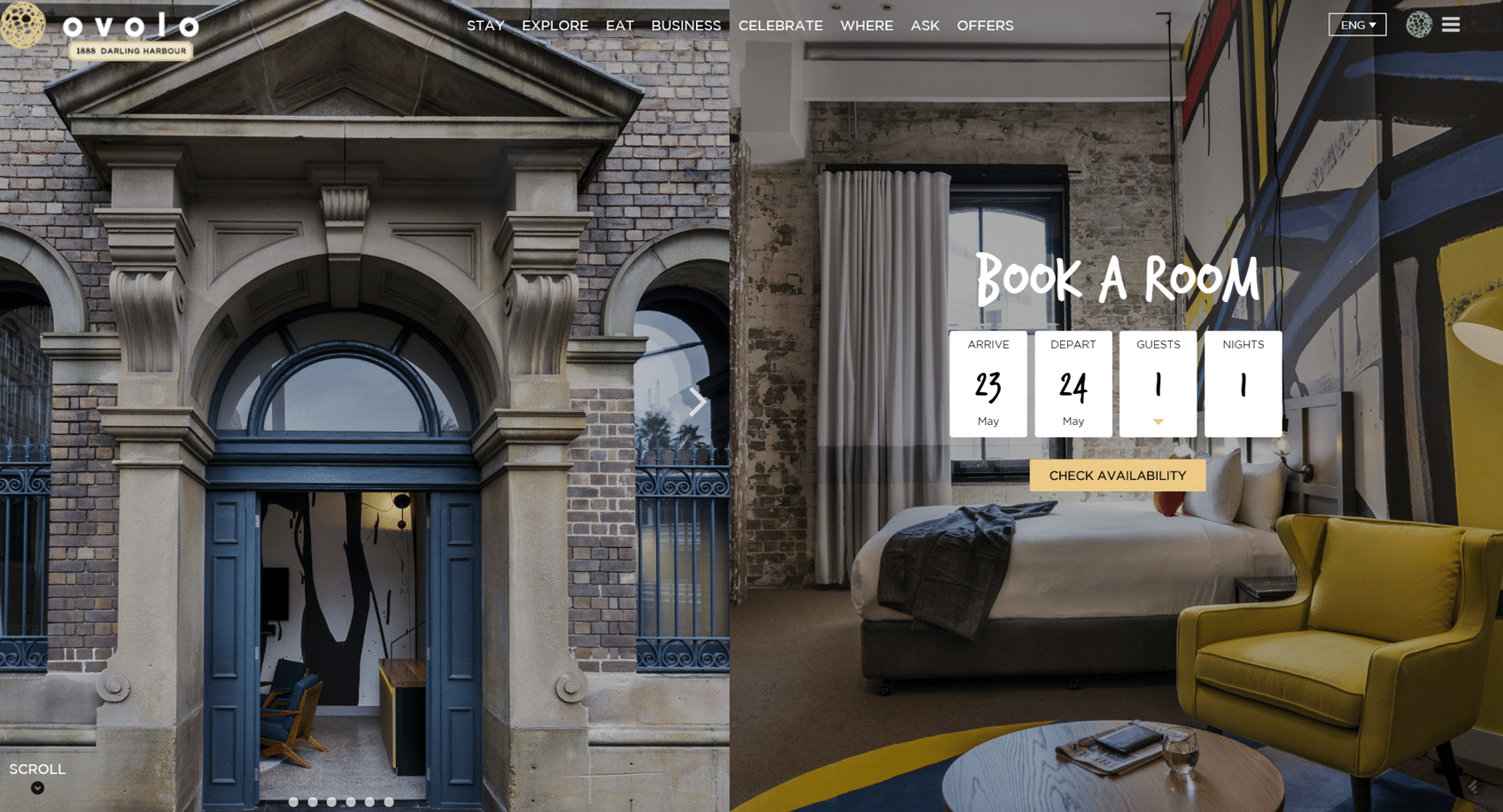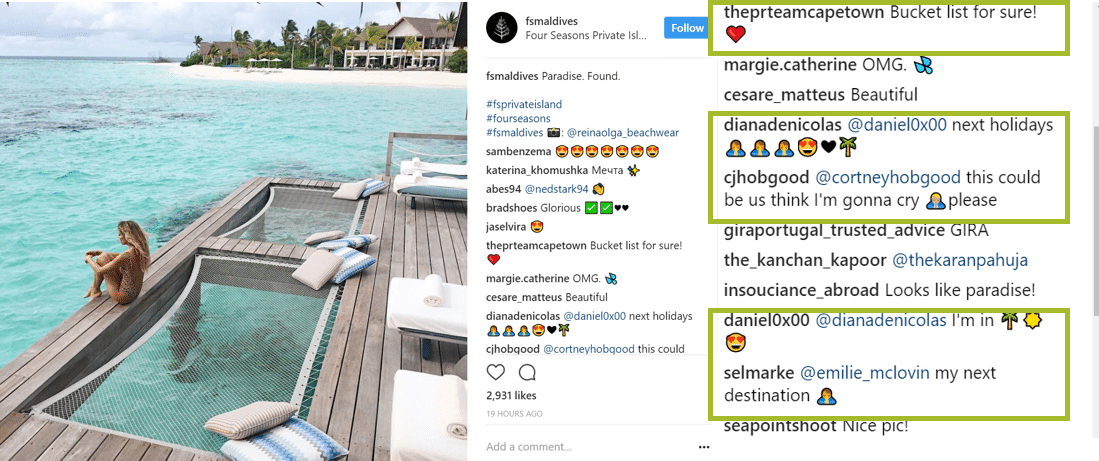There’s no question the digital marketing landscape is on the verge of yet another technological paradigm shift, the implications of which will directly impact how marketers acquire and keep customers. Businesses that fail to adapt – especially in the hotel/hospitality sector ” risk losing their competitive advantage, or worse, becoming obsolete. In this post, we’ll dissect the digital and consumer landscape along with its effect on the hotel consumer journey to show how smart companies can successfully achieve or grow ROI in the evolving eco-system with the customer front and center of it all.
The digital & consumer landscape
The hotel industry is one of brutal competition and continual evolution. From a financial perspective, the deep pockets of online travel agencies (OTAs) and ever-growing market power of disruptors like Airbnb force hoteliers to double down on digital marketing spend just to remain in the space. And that’s no exaggeration: When eMarketer asked how hotel professionals will be allocating 2017 budgets, 48 percent responded that the majority of spend would go toward digital marketing, and 44 percent said there would be high investment in social media strategy.
Operationally, technological shifts and digital disruptors have brought about a new era of tailoring operations to the unique and fluctuating expectations of hotel consumers. Loyalty is a scarcity and, at the end of the day, most consumers want shelter at the push of a button for the cheapest possible price.
When it comes to reaching customers in social, it’s important to note that fans only see a fraction of day-to-day organic company postings. An organic strategy is still crucial; however, without supplementing lost organic exposure with paid marketing, viral impressions aren’t going to bring home the bacon anytime soon. Take Marriott’s corporate Facebook profile for example: 2.5 million page likes seems like a healthy fan base, yet the brand scores only 40 to 140 likes per post.
Site traffic provides another hurdle for hotels, as Airbnb and OTAs like Hotels.com and Booking.com spend considerable sums on marketing campaigns that draw users to their site at greater volumes than ever before. Airbnb traffic surged over 30 percent since last year, bringing in over 106.9 million site visits. Assessing the top ten US hotel sites by traffic in Q1, Marriott and Hilton are the only two chains to break the top five, and even so, their site traffic experienced a decline of 8 percent and 6 percent respectively.
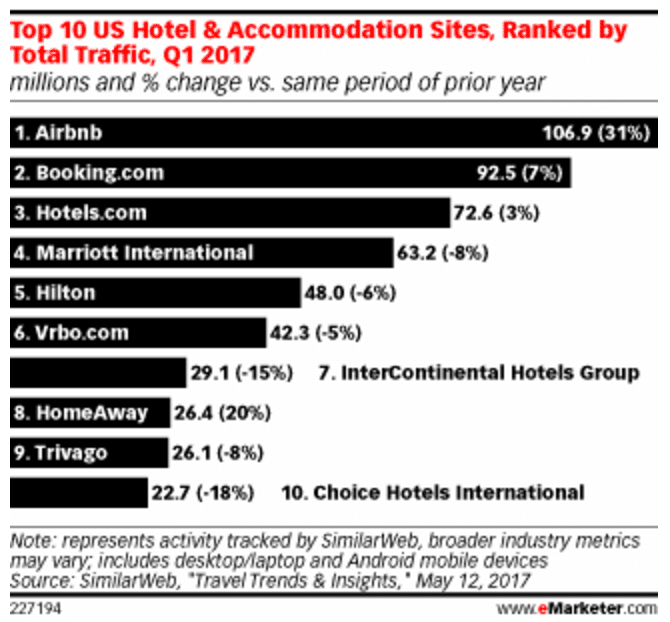
For hotels, this information is worrisome as an OTA campaign cannibalizes traffic while simultaneously cutting into hotel profits for charges incurred with customer referrals.
The hotel customer journey
When considering the plethora of channels and data available to build robust audience segments, the art of marketing a hotel lies in understanding how and when to influence travel shoppers during each stage of the travel shopping journey, and ultimately win their business. While the journey can vary in terms of length and time, it can be divided into four phases: research, acquisition, experience and post-stay.
Phase one: Research
Marketing tactics to leverage: demographic research, persona definition, SEO, PPC (informational), video, metasearch, paid social, mobile app downloads, reputation management/monitoring, AI
During the initial research phase, the user may or may not have already had exposure to your site. The important factor is that they have an intention or end-result in mind, and it is our job to be discoverable, relevant and help guide them through their journey as easily as possible.
At this point (and for the remainder of the customer journey) it’s key to determine the factors of consideration by persona:
- Who is the audience and why would they be interested in booking: Bleisure in search of a long weekend in wine country following a conference? Family of four ready for an action-packed week? Couple looking for a romantic getaway/proposal?
- Where are they coming from and when: Are they coming in via social? Search? Direct? OTA? Mobile? Tablet? Voice? Desktop? Are they first-time visitors or returning?
- What can you offer them? Strong mobile experience? FAQs? Reviews? Amenities? Content?
When assessing key search and booking periods, users are certainly shopping around for the best deal, but not as much as you may think: It’s estimated that 91 percent of travelers turn to search engines, and they visit an average of 4.5 sites before booking a hotel. Once hitting a site, though, they are putting in the time: Travel Tripper found that users spend an average of 29.8 minutes on a site before booking, and take 26 days from first search to reservation.
As we move from the research to acquisition phase, variances in journey behavior will emerge by audience type. For example, SiteMinder found that 58 percent of business travelers aren’t planning travel itineraries more than a week in advance, and 72 percent of them aren’t purchasing until around seven days prior to their departure. Aligning strategies to audience behavior will be the first step in providing a more meaningful and successful approach.
In Q1 2016, 40 percent of travel site visits in the US were performed on a mobile device, so mobile experience should be top of mind during the research phase. Other typical entry points to a hotel website include direct, organic search, paid search, metasearch, OTA/review sites and paid social. However, some hotels see an exponential number of users coming in from social media influence, by means of friends posting pictures with the brand property tagged.
If your site provides a less-than-stellar experience at this point in the journey, users will bounce faster than you can say “housekeeping!”. With almost two out of five mobile consumers abandoning a travel booking due to poor user experience, the recommended action for hoteliers to improve is to invest in mobile responsiveness. For direct bookings, a seamless, useful experience includes not only mobile responsiveness for users, but mobile-first optimization for added organic prominence.
Additional tips for attracting users in the research phase:
- Invest in top-of-funnel paid channels and ad formats to pique users’ interest as they begin their travel search and become familiar with brands and offers.
- Put the most pertinent content front and center, avoid making users zoom in to learn more and don’t waste their time by redirecting them to another site.
- Leverage photos, amenities, promotions and blog content to help ease a searcher’s experience. Providing content related to landmarks surrounding your hotel is a fantastic way to get your foot in the door with users scoping out the area, without wasting time trying to dominate SERP space for competitive terms such as “hotels near me.”
Phase two: Acquisition
Marketing tactics to leverage: SEO, PPC, paid social, mobile app, chatbots, AI integration, LTV evaluation
Digital marketing provides unparalleled insight into our target audiences, giving marketers the ability to tap into not just site behavior, but intention for top-notch audience acquisition. Facebook owns boundless third-party in-market travel and hospitality targeting capabilities, and Google’s Display Network has in-market travel topics and placements that can be layered along with site behavior.
Before putting money behind any direct-booking acquisition, take the time to understand and segment customer LTV to know who your best audiences are and the value they provide to the current marketing ROI. This will help lay the foundation for a successful long-term digital strategy.
Once a prospective traveler has been exposed to the site, relevancy and simplicity are keys to securing a reservation. Before pulling the trigger, customers browse through hotel names, images, price and location as well as user ratings, but they fixate on images. A great image can make up for less-favorable ratings or a lesser-known brand logo.
Travelers are looking for ease, personalization and information, and if they can’t easily get that from you, they’ll go to the competition. Again, an effective mobile experience must be a front-and-center consideration during this period as mobile travel searches overtake desktop during the research and booking phases. Google states that 40 percent of travel and retail website visitors will abandon a site after three seconds if it doesn’t load, and 40 percent of those who leave won’t return. An effective homepage contains critical information needed for booking (availability, price, ratings, images). Limiting the amount of redirects and steps in the process is another tactic that reduces the amount of effort from an end-user and factors into conversion rate increases.
When convincing users to book through your hotel versus others, hoteliers have vast opportunity during this period to provide meaningful and helpful experiences through paid and organic content and site experience. The adoption of artificial intelligence and chatbots in the travel industry, for example, has brought improvements to personalized and streamlined booking experiences.
Once you’ve dissected your core audience segments and how and where they interact with the site, create implicit forward pressure to book direct through the following messaging constructs:
- FOMO (fear of missing out): Highlight how many rooms are left, how much time is left at the price or how many people are also considering the room.
- Reassurance: Make it very clear that the lowest price is guaranteed from the direct site, and that once booked, the user will be guaranteed a safe and enjoyable experience.
- Flexibility: If free shuttles, early check-ins or late-check outs are available by booking direct, state it.
- Answering questions: Understand what your customer really wants. Families may require a pool, while bleisure cares about laundry service and meeting rooms.
The above messaging can be applicable to both organic, paid and site content; the important takeaway is that there is a deep understanding of customer objectives and how to exceed their wants and expectations.
Phase three: Experience
Marketing tactics to leverage: beacons, geofencing, social media community management, push-notifications, mobile app optimization
After a booking is confirmed, many hotels think the work is over, when in reality it has only just begun. The guest experience begins long before stepping foot on the property, extends through the guest’s return home and is completely up to the hotel to influence in a positive way. It’s more than a Snapchat filter or a pretty chair. A strong experience strategy empowers users with the propensity to share their story and inspire others to move through or create their own customer journey.
During the experience phase, guests are forming opinions based on the quality of service, level of convenience and caliber of aesthetics, so it’s important that operations align with marketing efforts. Even with the strongest marketing plans, if you deceive guests by referring to an understaffed, under-construction, under-maintained hotel as a “stress-free getaway oasis,” it will backfire quickly.
Enhance a user’s stay immediately by using beacons, geofencing and push notifications for arrival/welcomes, happy hour specials, text/chat room service, hotel events and check-out reminders. Many chains are responding to the growth of voice search by implementing digital assistants in rooms for a more personalized and convenient stay. The assistants can be summoned by voice to control room climate, lights, music, television and more. Chatbots are also a valuable technology to leverage during a guest’s stay as they provide 24/7 service without the guest having to call or head down to the front desk. From fresh towels to restaurant recommendations and complaint escalation, natural conversational language can be baked-in and backed up with live assistance when necessary. Internally, chatbots help improve robust customer profiling, improve loyalty and boost hotel RevPAR.
Finally, use social to take advantage of every opportunity to humanize your brand. Today’s travelers are more likely to share their experiences than ever before, and it’s unfortunate how many hotels are missing out on engaging with their customers.
Amp your customers’ hotel experience by:
- Sprinkling local events and seasonal celebrations within your current social posting mix.
- Encouraging guests to share their experiences. Monitor brand sentiment through community management and social listening tools, and respond and request to share their content.
- Displaying hashtags associated with the hotel around the premises. Bonus points for displaying customer-shared images on a TV or screen within the lobby.
- Leveraging user-generated content (UGC) within your organic and paid marketing strategies. UGC can provide incremental referral traffic, as 52 percent of people report being inspired to travel due to a friend’s social post and 84 percent of consumers trust earned media over all forms of advertising.
Phase four: Post-stay
Marketing tactics to leverage: social media community management, reputation management, marketing automation/email
Once a guest has concluded their stay, the goal is that they’ve left satisfied and eager to return. Repeat guests not only cost less than acquiring new, but can also act as brand ambassadors, amplifying your hotel as a gold standard for incomparable guest service. In the post-stay phase, hotel marketers must make the effort to collect (and respond to) reviews. 53 percent of people won’t book a hotel without reviews, and when a hotel responds to an online review, travelers are 62 percent more likely to book.
Leveraging email and paid search/social retargeting tactics will be the best means of following up with guests after their stay. Loyalty programs, incentives and updates provide great fodder for a nurture strategy to keep their experience (and your hotel) fresh in their minds.
Regardless of technological shifts or digital disruptors, effective marketing will continue to center around driving revenue through magnanimous and memorable experiences that empower customers through their buying journey. By mapping out future marketing strategies to the four phases of the customer journey, hotels gain a tremendous opportunity to craft a genuine and impactful connection with guests while moving business forward.
Image credits:
Africa Studio/Shutterstock.com
Soloviova Liudmyla/Shutterstock.com
Vadim Georgiev/Shutterstock.com

